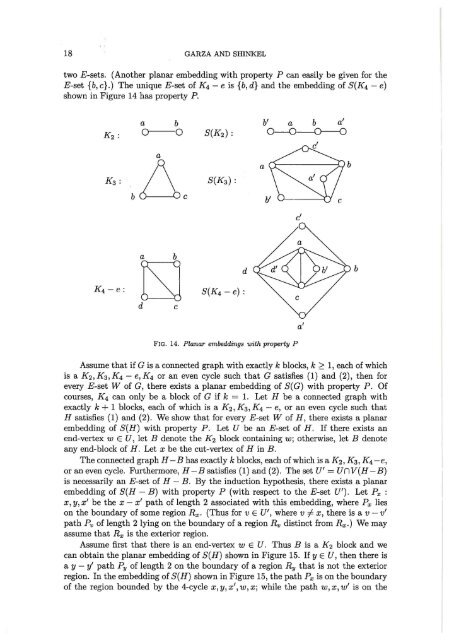Create successful ePaper yourself
Turn your PDF publications into a flip-book with our unique Google optimized e-Paper software.
·'<br />
18 GARZA AND SHINKEL<br />
two E-sets. (Another planar embedding with property P can easily be given for the<br />
E-set {b, c}.) The unique E-set of K4- e is {b, d} and the embedding of S(K4 - e)<br />
shown in Figure 14 has property P.<br />
a b b' a b a'<br />
K2: 0 0 S(K2): 0--0---0----0<br />
PLANAR SHADDOW GRAPHS 19<br />
boundary of the exterior region. Hence this embedding of S(H) has property P. The<br />
argument is similar if U contains no end-vertex and B is a K 2 block.<br />
w'<br />
X<br />
a<br />
·bDc<br />
K3: S(K3):<br />
a<br />
b<br />
w<br />
x'<br />
c'<br />
S(H - B) S(B) S(H)<br />
FIG. 15. Producing a planar embedding of S(H) with property P when B = K2<br />
lSJ<br />
d<br />
c<br />
S(K4- e):<br />
d<br />
b<br />
Thus we may assume that B is an end-block which is a K3, K4- e, or an even<br />
cycle. The set U" = U n V(B) is an E-set in B and hence there exists a planar<br />
embedding of S(B) with property P (with respect to U"). Let P~ : x, z, x' be the<br />
x-x' path of length 2 associated with this embedding, where P~ lies on the boundary<br />
of a region R~. Again, we may assume that R~ is the exterior region. We can now<br />
combine the embeddings of S(H - B) and of S(B) to produce the embedding of S(H)<br />
shown in Figure 16.<br />
a'<br />
FIG. 14. Planar embeddings with property P<br />
Assume that if G is a connected graph with exactly k blocks, k 2: 1, each of which<br />
is a K2, K3, K4- e, K4 or an even cycle such that G satisfies (1) and (2), then for<br />
every E-set W of G, there exists a planar embedding of S(G) with property P. Of<br />
courses, K 4 can only be a block of G if k = 1. Let H be a connected graph with<br />
exactly k + 1 blocks, each of which is a K 2 , K 3 , K 4 - e, or an even cycle such that<br />
H satisfies (1) and (2). We show that for every E-set W of H, there exists a planar<br />
embedding of S(H) with property P. Let U be an E-set of H. If there exists an<br />
end-vertex w E U, let B denote the K 2 block containing w; otherwise, let B denote<br />
any end-block of H. Let x be the cut-vertex of H in B.<br />
The connected graph H - B has exactly k blocks, each of which is a K 2 , K 3 , K 4 - e,<br />
or an even cycle. Furthermore, H -B satisfies (1) and (2). The set U' = UnV(H - B)<br />
is necessarily an E-set of H- B. By the induction hypothesis, there exists a planar<br />
embedding of S(H- B) with property P (with respect to the E-set U'). Let Px :<br />
x, y, x' be the x- x' path of length 2 associated with this embedding, where Px lies<br />
on the boundary of some region Rx. (Thus for v E U', where v f. x, there is a v - v'<br />
path Pv of length 2 lying on the boundary of a region Rv distinct from Rx.) We may<br />
assume that Rx is the exterior region.<br />
Assume first that there is an end-vertex w E U. Thus B is a K 2 block and we<br />
can obtain the planar embedding of S(H) shown in Figure 15. If y E U, then there is<br />
a y - y' path Py of length 2 on the boundary of a region Ry that is not the exterior<br />
region. In the embedding of S(H) shown in Figure 15, the path Px is on the boundary<br />
of the region bounded by the 4-cycle x, y, x', w, x; while the path w, x, w' is on the<br />
x'<br />
S(H- B) S(B) S(H)<br />
FIG. 16. Producing a planar embedding of S(H) with property P when B =/= K2<br />
If either y or z belongs to U, then the associated paths Py and Pz lie on the<br />
boundary of a non-exterior region. In the embedding of S(H) shown in Figure 16,<br />
both Px and P~ lie on the boundary of the region bounded by the 4-cycle x, y, x', z, x.<br />
Thus either Px or P~ completes the required condition for this embedding of S(H) to<br />
have property P, and the proof is complete. D<br />
Acknowledgement. The research advisor for this project was Prof. Gary Chartrand.<br />
REFERENCES<br />
[1] K. APPEL, W. HAKEN and J. KocH, Every planar graph is four-colorable, Illinois J. Math. 21<br />
(1977) 429-567.<br />
[2] J. B. KELLY and L. M. KELLY, Paths and circuits in critical graphs, Amer. J. Math. 76 (1954)<br />
786-792.<br />
y<br />
z
















